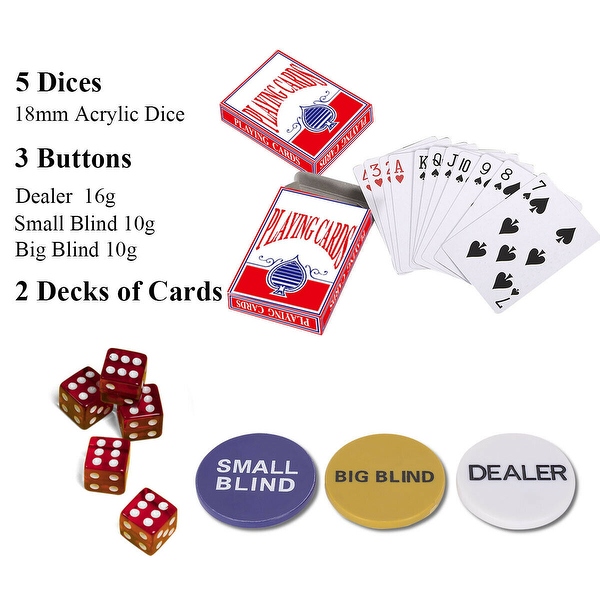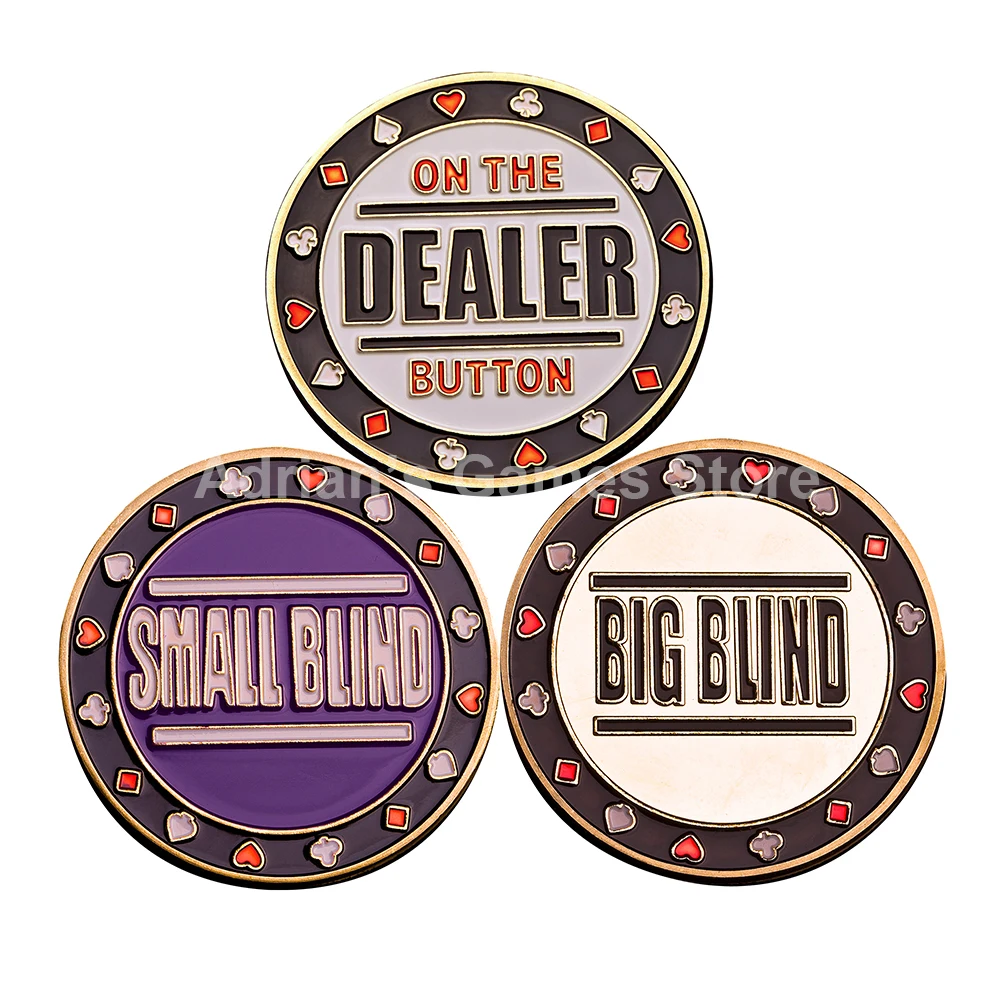Poker Chips Big Blind
Nothing seems to confuse new Texas hold 'em players more than the blinds. Let's sort it out.
I used to play stud and draw poker with neighbors. I don't still play, but like to read about poker strategy. Would you please explain how the big blind and little blind work in hold 'em? I'm sure many of us who read LuckyDog have no idea. — Dale H., Kankakee, Ill.
Well, Dale, since I had the same question this month from John, a co-worker of mine in Moline, Ill., it's a good time to explain the blinds in hold 'em.
Professionals and novices alike can find poker chips, decks of cards, and other useful items at competitive prices, such as card shufflers that help keep games moving at a fast clip, or blind buttons that make tracking down the big and small blinds easy. Re: Poker & 888 Poker Display in BigBlinds I always played in chips but recently changed to BB and I can only say that I think it helps. When I played in chips I sometimes missed blind going up.
Think of the blinds as antes used to stimulate betting and initiate play. There's one key difference: Unlike stud and draw poker, in which every player must pay the same pre-determined ante before each deal, in hold 'em only the first two players to the left of the dealer position have to post a blind.
The dealer for each hand is designated by a round disk called a button. Except for the first betting round, the player with the dealer button gets to act last throughout the hand. On the first betting round, the two players in the blinds act after the button, then are first to act on remaining betting rounds.
The button moves clockwise one position for each new hand. That rotates the advantage of last action and assures that for every circuit of the button around the table, each player will pay the two blinds once. The little blind usually is half the amount of the big blind.
Here's an example:
You're in seat five of a nine-handed $4-$8 limit hold 'em cash game and the dealer button reaches seat three. That means you are in the big blind position and must put $4 in front of you before the cards are dealt. The player to your right in seat four must post the $2 small blind.
Big Blind Poker Chips
Two down cards are then dealt to each player, starting with the small blind. On the first betting round, action starts with the player to your left in seat six, a position called 'under the gun,' meaning first to act.
From the big blind, you are last to act before the flop. If no one has raised (to $8 in this case) when the action gets back around to you, you have two options — you can check, since you're already in for the $4 bet, or you can raise to $8. Don't fold. Even a lousy 7-2 offsuit can turn into quads on a perfect flop!

If someone raises before the action gets back to you pre-flop, you have three options: fold and forfeit your $4; call the additional $4, or re-raise by betting $8 more for a total of $12.
After the flop, the betting rotation changes. The player in the small blind on your right acts first for the rest of the hand, then you. If he has folded, you're first to act each round until the hand ends.
On the next hand, the button moves to seat four. Now you're in the small blind position and must post $2 before the deal. To stay in the hand, you must match the bet amount when it's your turn ($2 more if no one raises). Or you can fold, losing your $2 small blind.
On the next hand, you get the dealer button and can see your starting hands for free until it's time to post the blinds again.
We'll tackle playing strategies from the blind positions in a future column, Dale and John, but for now here are some other things to know:
— Some card rooms play hold 'em with a 'dead' button. That means the big blind is posted by the seated player due for it, and the small blind and button are positioned accordingly, whether or not players actually are seated there to receive a hand. This gives last-action advantage to a player on consecutive hands.
— If you miss paying one or both blinds, you must post the appropriate amount when you return or sit out until the big blind position advances to you. If you post mid-circuit, you still must pay the blinds when they reach you a few hands later in that round.
— When joining a game in progress, some card rooms require that you post the big blind amount if you want to be dealt in right away. You can choose to sit out until the big blind position reaches you normally, which is a good option because you can watch a few hands risk-free and get a feel for the table's action.
Poker Chips Big Blind Auditions
— In heads-up play using two blinds, the small blind is on the button. That player acts first before the flop and last on each subsequent betting round.
E-mail your poker questions and comments to [email protected] for use in future columns. To find out more about Russ Scott and read previous LuckyDog Poker columns, visit www.creators.com or www.luckydogpoker.com.
If you’re playing in a cash game that’s capped, but is described as offering full buy-ins, you may be playing under the “100 BB” (Big Blind) rule. As an example, 100 big blinds in a $1/$2 game is $200, which is often the maximum allowed in this type of game. (Certain games can feature maximum buy-ins of 30, 35 or 40 big blinds, and these are generally referred to as “short stack” games.) For general purposes this article is for cash games. Please see our article for the 10 bb rule in tournaments.
The 100 BB Importance
What’s so important about the 100 big-blind level, and how did it come to be? First, it’s easy math, and cashiers and chip runners like their jobs to be easy as possible. Second, and more importantly, a game featuring full buy-ins allows for the full gamut of strategy of no-limit poker to come into play. 100-BB cash-game poker is the complete game, allowing for bluffs, finesses, re-steals, squeezes, traps, and all the other bits and pieces that make poker such a dynamic game to play.
Keep it at This Amount

Because of this, many experienced players reload for another 100 BB in chips any time their chip stack falls below this level. Experienced, versatile (and properly-bankrolled) players perform at their best when they have lots of chips to work with, and at all times they can only win as much from another single player as the amount of chips their own stacks hold. The shortest stack at any given table has the least to lose… but he also has the least to win.

Poker Chips Big Blinds
Another way to think of it is like this: If you are better than your opponents, you want to be able to win as many of their chips as possible. Because of this, you want to have all or many of them outchipped at any given time. We’ll ignore the opposite for the most part and just note that if you’re not better than most of your opponents, you’re sitting at the wrong table.
Poker Chips Big Blind Visually
Rule of thumb, Time to Rebuy
The 100-BB rule, therefore, is simply a general reminder to good players that it might be time to rebuy and get some more chips into play. Maybe you’ve taken a bad beat, or two, or three, but if you can avoid tilt and you know your opponents are worse than you, remember that the cards themselves have no memory.
And go ahead and reload – another 100 BB’s should do the trick.
Author:Joseph Falchetti (twitter)
(C) Copyright PokerWebsites.com, 2018